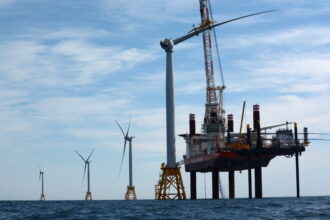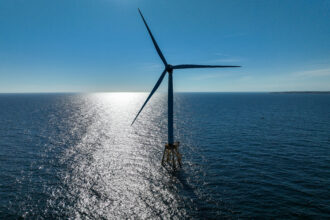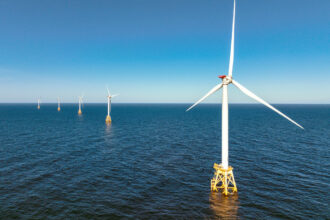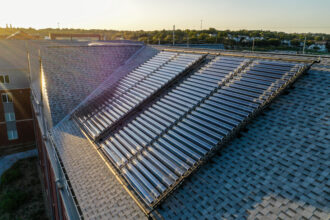The Biden administration’s latest lease offering for offshore wind projects doesn’t allocate adequate acreage for Maryland and other mid-Atlantic states to achieve their legally binding emissions reduction and clean energy targets, industry groups and environmental advocates say. They believe the offering also further hobbles the offshore wind industry, which already faces supply constraints, a lack of new tax credits and high interest rates.
A dedicated part of President Biden’s Investing in America agenda, the proposed lease was announced on Tuesday by the Interior Department and includes one area off Delaware and Maryland and another situated off Virginia, totalling almost 278,000 acres. The two areas can potentially support 4 to 8 gigawatts of renewable energy, according to the Bureau of Ocean Energy Management (BOEM).
But dropped from the proposal is an area totalling 78,285 acres, called B-1 in administrative shorthand, located nearly 24 miles off Ocean City, Maryland, which was listed among the sites BOEM finalized in July, apparently because of concerns expressed by the Coast Guard, the Defense Department and other agencies.
Under its new law mandating development of renewable energy, Maryland alone must produce 8.5 gigawatts from offshore wind by 2031.
“The Biden Administration had the opportunity to provide all the lease area needed to allow Maryland to achieve our goal of building 8.5 gigawatts of offshore wind, but they opted not to,” said Jamie DeMarco, Maryland director of the Chesapeake Climate Action Network.
The latest offering is part of the federal government’s efforts to achieve the goal of deploying 30 gigawatts of offshore wind energy capacity by 2030, and serves as a key plank of the White House’s strategy to decarbonize the energy sector by revitalizing domestic supply chains through subsidies and tax cuts included in the Inflation Reduction Act.
“The bureau had to look at potential conflicts with a United States Coast Guard safety fairway, commercial fishing, Department of Defense activities, a NASA danger zone, and marine habitat areas,” BOEM said after finalizing the three areas for lease on July 31.
BOEM also mentioned a rash of migrating whale deaths along the Atlantic coast and the possible impact of wind farm activities on whales, but said the National Oceanic and Atmospheric Administration (NOAA) had ruled out that offshore wind activity caused any harm to whales.
In excluding the B-1 area, the Interior Department said that it has identified another area off Maryland’s coast “of a similar size and wind energy generation capacity to B-1,” which will be further analyzed for possible inclusion in a 2025 lease along with additional potential offshore wind areas along the Central Atlantic coastline.
The two areas open for leasing off Maryland, Delaware and Virginia “have the potential to power over 2.2 million homes with clean energy,” the department said in a statement, adding that the sale of the two currently proposed sites will go ahead in mid-2024.
But environment and industry experts said that the decision to scale back the lease area can complicate the ability of the states such as Maryland, as well as Virginia and North Carolina, who are banking on offshore wind projects to achieve their renewable energy and clean energy goals.
Maryland established one of the most ambitious offshore wind goals nationwide after Gov. Wes Moore signed the Promoting Offshore Wind Energy Resources (POWER) Act into law in April, setting the goal of producing 8.5 gigawatts of electricity from offshore wind sources by 2031. The state is expected to play a key role in achieving the national target of 30 gigawatts in offshore wind by 2030.
“We have made it clear that we are going to work to ensure that Maryland accelerates its growth in the clean energy economy, and we are committed to reaching our goal of creating 8.5 gigawatts of offshore wind energy,” Moore said in a statement on Dec. 11. “I look forward to our continued partnership with federal and industry partners to help Maryland reach its goals to help the country reach its goal of deploying 30 gigawatts of offshore wind energy capacity by 2030.”
Moore, who announced in April his plan to achieve 100 percent clean energy by 2035 and wind energy to be the mainstay of 21st century Maryland economy, did not elaborate what the Interior Department’s scaling back of the lease area could mean for the state’s renewable energy goals. The governor’s office referred to the Department of the Interior statement on the proposed lease decision when asked for comments.
Sen. Chris Van Hollen of Maryland said that it took a series of meetings and significant dialogue with the Biden Administration and key stakeholders to reach an agreement on offshore wind leasing in the Central Atlantic that ensures Maryland can make progress toward meeting its wind energy deployment goals. “While there’s more work to do, this agreement is an important step toward increasing our energy security and fighting the climate crisis,” a Department of Interior statement on Dec. 11 quoted him as saying. Like Moore, Van Hollen did not mention why the B-1 leasing area had been dropped.
Maryland is legally required to meet its ambitious goal of 60 percent greenhouse gas reduction by 2031, which, environmental groups such as the Chesapeake Climate Action Network say, will be difficult to meet without shoring up offshore wind potential. In addition to Maryland’s POWER Act, Virginia is by law required to build 5.2 gigawatts and North Carolina is slated to build 8 gigawatts of offshore wind.
In August, roughly 30 organizations representing a mix of regional and local advocacy and trade groups, signed a statement urging BOEM to reconsider its wind energy area map and include more offshore space for wind energy projects beyond the two areas announced on Tuesday and the B-1 area that was dropped.
“Maryland will not be able to achieve our climate goals if the lease areas offered are not adequate, and so we are urging BOEM to ensure Maryland can meet its commitment to offshore wind,” the statement said. It added that an inadequate Central Atlantic lease sale area “will cost Maryland jobs, worsen our health outcomes, and make it impossible to meet our climate goals.”
Firing a warning shot, the trade groups and environmental advocates said that if BOEM failed to lease sufficient acreage in the Central Atlantic to meet Maryland’s legally binding clean energy goals, “then supply chain companies will be less likely to make investments in Maryland, and we could even see existing commitments rolled back.”
This story is funded by readers like you.
Our nonprofit newsroom provides award-winning climate coverage free of charge and advertising. We rely on donations from readers like you to keep going. Please donate now to support our work.
Donate NowFrank Macchiarola, chief policy officer of American Clean Power, a lobbying group representing a broad array of clean energy companies, said the lease areas in the proposed sale notice fall well short of state offshore wind and renewable energy goals.
“The federal government needs to work closely with industry and their state partners to identify areas that are of sufficient size to meet their emissions reduction targets and develop the supply chain,” Macchiarola said.
This can lead to a reduction in the overall planned capacity for domestic production of offshore wind energy, he said, which could hamper the development of a robust supply chain. “It may force developers to revise their capital investments, leasing strategy and production plans to adjust their targets accordingly,” Macchiarola added.
Liz Burdock, founder and CEO of Oceantic Network, which represents offshore and ocean renewable industry, said in a statement that mid-Atlantic states like Maryland depend on offshore wind as the mainstay of their clean energy futures and have created policies to position the region as an industry manufacturing and logistics hub.
“New investors in the supply chain are looking for a consistent, long-term project pipeline,” Burdock said. “It is extremely important that the Biden and the Moore administrations jointly announced an effort to delineate new areas for development in service of Maryland’s 8.5 GW goal.”
She cautioned that the signals being sent to the longer-term market are extremely important to foster additional supply chain investments today. “As the current acreage identified does not yet meet those goals, it is imperative that our federal and state governments lay out a clear pathway to achieving state commitments,” she said.
In a recent letter to BOEM Director Liz Klein, a coalition of environmental nonprofits and trade groups urged the bureau to facilitate the industry’s growth by expanding the space available for offshore wind in the Central Atlantic, adding that in the best case scenario the space available for leasing in the Central Atlantic can only accommodate 4 to 8 gigawatts of offshore wind projects.
Striking a reassuring note, the Department of the Interior said that the Biden administration and the leadership in Maryland will collaborate in advancing review of additional areas that could support the goals of Maryland’s POWER Act.
Since President Biden’s election, the Department of the Interior has held four offshore wind lease auctions, bringing in almost $5.5 billion in bids. BOEM will prepare a draft environmental assessment to evaluate the potential environmental impacts from lease issuance within the Central Atlantic, which comprises New York, New Jersey, Pennsylvania, Delaware, Maryland, and Washington, D.C.













